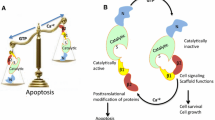Abstract
We employed RNA interference to determine the role of tissue transglutaminase II (TGase II) in motility of cancer cells. Down-regulation of TGase II by small interfering RNA against TGase II impaired adhesion and motility of HeLa cells by decreasing phosphorylation of the protein kinase, Akt, and reactive oxygen species (ROS). Over-expression of TGase II showed opposite effects. These results suggest potential utility of TGase II for development of therapeutic anti cancer vaccine.
Similar content being viewed by others
References
Akimov SS, Belkin AM (2003) Opposing roles of Ras/Raf oncogenes and the MEK1/ERK signaling module in␣regulation of expression and adhesive function of␣surface transglutaminase. J Biol Chem 278:35,609–35,619
Bergamini CM, Signorini M, Barbato R, Menabo R, Di Lisa F, Gorza L, Beninati S (1995) Transglutaminase-catalyzed polymerization of troponin in vitro. Biochem Biophys Res Commun 206:201–206
Fabbi M, Marimpietri D, Martini S, Brancolini C, Amoresano A, Scaloni A, Bargellesi A, Cosulich E (1999) Tissue transglutaminase is a caspase substrate during apoptosis: cleavage causes loss of transamidating function and is a biochemical marker of caspase 3 activation. Cell Death Differ 6:992–1001
Gaudry CA, Verderio E, Jones RA, Smith C, Griffin M (1999) Tissue transglutaminase is an important player at the surface of human endothelial cells: evidence for its externalization and its colocalization with the beta (1) integrin. Exp Cell Res 252:104–113
Haroon ZA, Hettasch JM, Lai TS, Dewhirst MW, Greenberg CS (1999) Tissue transglutaminase is expressed, active, and directly involved in rat dermal␣wound healing and angiogenesis. FASEB J 79:1787–1795
Kang SK, Lee JY, Chung TW, Kim CH (2004) Overexpression of transglutaminase 2 accelerates the erythroid differentiation of human chronic myelogenous leukemia K562 cell line through PI3K/Akt signaling pathway. FEBS Lett 577:361–366
Lee ZW, Kwon SM, Kim SW, Yi SJ, Kim YM, Ha KS (2003) Activation of in situ tissue transglutaminase by intracellular reactive oxygen species. Biochem Biophys Res Commun 305:633–640
Mohan K, Pinto D, Issekutz TB (2003) Identification of tissue transglutaminase as a novel molecule involved in human CD8+ T cell transendothelial migration. J␣Immunol 171:3179–3186
Oliverio S, Amendola A, Di Sano F, Farrace MG, Fesus L, Nemes Z, Piredda L, Spinedi A, Piacentini M (1997) Tissue transglutaminase-dependent posttranslational modification of the retinoblastoma gene product in promonocytic cells undergoing apoptosis. Mol Cell Biol 17:6040–6048
Stephens P, Grenard P, Aeschlimann P, Langley M, Blain E, Errington R, Kipling D, Thomas D, Aeschlimann D (2004) Crosslinking and G-protein functions of␣transglutaminase 2 contribute differentially to fibroblast wound healing responses. J Cell Sci 117:3389–3403
Takahashi H, Isobe T, Horibe S, Takagi J, Yokosaki Y, Sheppard D, Saito Y (2000) Tissue transglutaminase, coagulation factor XIII, and the pro-polypeptide of von Willebrand factor are all ligands for the integrins α 9β 1 and α 4β 1. J Biol Chem 275:23,589–23,595
Yuan L, Choi K, Khosla C, Zheng X, Higashikubo R, Chicoine MR, Rich KM (2005) Tissue transglutaminase 2 inhibition promotes cell death and chemosensitivity in glioblastomas. Mol Cancer Ther 4:1293–1302
Acknowledgments
This work was supported by a grant from (0103026-1-2) from the Basic Research Program of the Korea Science & Engineering Foundation, a grant from Korea Research Foundation and Vascular System Research Center, a grant from Korea Research Foundation (0805011-1-1), and a grant (A050260) from the Ministry of Health and Welfare of Korea.
Author information
Authors and Affiliations
Corresponding author
Rights and permissions
About this article
Cite this article
Bae, J., Lee, YS. & Jeoung, D. Down-regulation of transglutaminase II leads to impaired motility of cancer cells by inactivation of the protein kinase, Akt, and decrease of reactive oxygen species. Biotechnol Lett 28, 1151–1158 (2006). https://doi.org/10.1007/s10529-006-9079-6
Received:
Accepted:
Published:
Issue Date:
DOI: https://doi.org/10.1007/s10529-006-9079-6




